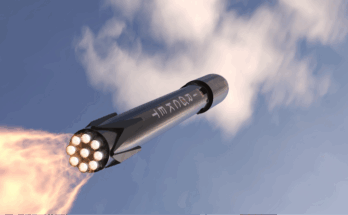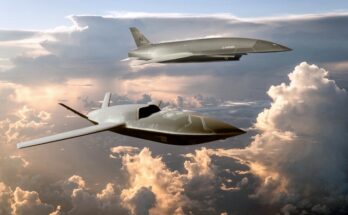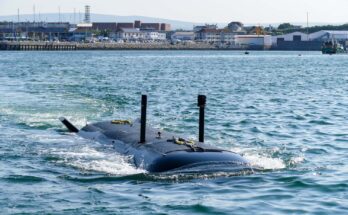
By C. Zachary Hofer and Carter Palmer
From the end of January and into February, an uncommon object captured the attention of observers around the globe, but probably none more so than the Canadian and U.S. citizens over which it flew. The object in question? A Chinese surveillance balloon, floating in the stratosphere – first across the Aleutian Islands of Alaska, onward into Canada, and crossing again into the U.S. via Idaho. The balloon ultimately met an untimely demise, suffering a violent end – death by ballistics launched from a U.S. Air Force F-22. Location: the U.S. exclusive economic zone (EEZ), off the coast of South Carolina.
Whether you believe the Chinese government’s assertions that the high-altitude balloon was meant for weather observation and went unexpectedly wayward or the U.S. government’s contention that the balloon was deliberately sent with more nefarious intentions – to surveil U.S. military sites – both parties agree that the balloon was meant for surveillance. Whether to observe weather or sensitive military secrets, both fit the bill for surveillance.
Using balloons to gather information is nothing new. Weather balloons, for example, have been used for over a century for observation of our planet’s environment, but not all balloon use has been so peaceful. Over their long history, balloons have also been used for war purposes. Low-altitude, hot air balloons were used for surveillance during World War I. And in World War II, the Japanese government used “Fu-Go” balloon bombs, launching over 9,000 examples. In the U.S., the Fu-Go balloons caused only minor damage but killed at least six U.S. civilians in Oregon.
Of course, technology has changed since the Second World War. As a class of such technological innovations, satellites have become one of the major intelligence gatherers for countries with the capability to deploy them – China included.
One of the major questions people have been asking over the past week is, Why a balloon and not just a satellite? Do balloons have advantages over satellites, or is this simply a provocative tactic designed to set North Americans on edge?
First some background. This is just the most recent public report of a Chinese balloon to appear over American skies, not the first. On Thursday, February 2, U.S. Department of Defense officials held a press conference to clarify the facts around the balloon and revealed that Chinese surveillance balloons had crossed into U.S. territory not just during President Biden’s administration, but in previous ones as well.
But again, why balloons and not satellites?
The answer could in part be that balloons, being closer to the ground, would theoretically have better photo-taking ability. A balloon is also capable of loitering for long periods over a target (low-Earth-orbit (LEO) satellites do not have this capability; by definition, geostationary (GEO) satellites do). Balloons are also far cheaper to build, deploy, and operate. But they are much more noticeable.
While miniscule in the vast sky, there were reports across the U.S. of observers being able to see the Chinese surveillance balloon with their bare eyes. By contrast, a satellite is, under most circumstances, not visible to those on the ground. By necessity, satellites are significantly smaller than the Chinese balloon (reportedly the size of three city buses), and they fly significantly higher in the sky.
But still, why a balloon and not a satellite?
Well, first off, there are almost certainly Chinese military surveillance satellites with their eyes trained on the U.S. at this very moment. So, with surveillance capability already gained from space, why also send a highly noticeable surveillance balloon and provoke an international outcry by crossing sovereign boundaries illegally? One answer can be found in the sensor set.
As far as the public is concerned, the balloon’s sensor set is unknown, but let us hazard some guesses as to why a balloon would be preferable to a satellite sensor-wise.
According to the European Space Agency, a satellite in LEO “is normally at an altitude of less than 1,000 km (3,280,837 ft) but could be as low as 160 km (524,934 ft) above Earth.” At that altitude, even in the lowest bounds, a sensor becomes significantly more vulnerable to electromagnetic interference from space.
According to the National Oceanic and Atmospheric Administration (NOAA), the stratosphere, which is where the Chinese surveillance balloon was flying, extends “around 31 miles (50 km; 164,042 ft) down to anywhere from 4 to 12 miles (6 to 20 km; 19,685 to 65,617 ft) above the Earth’s surface.” This far inside the atmosphere, even in the high altitudes of the stratosphere, a sensor is greatly protected from extraterrestrial electromagnetic interference, lowering the signal noise floor’s dBs by magnitudes and thus tremendously enhancing signal strength, clarity, and fidelity. Consequently, the major benefit of a stratospheric surveillance balloon is as a signals intelligence platform. It can much more easily collect data from the electromagnetic spectrum, intercepting radio communications and radar transmitter data with far higher fidelity.
So why did the military wait so long to shoot the balloon down?
The DoD’s statements that it did not want to endanger the public by shooting down a large object over populated areas is plausible, but also, sort-of not. The balloon’s flight path crossed large, very sparsely populated areas of the country. It could have been taken down several times over with little likely harm to the public.

Then why wait?
The U.S. military has some of the most sophisticated signals jamming faculties in the world. It is likely that the balloon’s path was covered by some sort of electronics countermeasures. It would go a long way to explaining why airports were shut down as the balloon passed overhead.
Flying in the stratosphere, a balloon of this type poses essentially zero danger to most air traffic. Commercial air traffic cruises at approximately 31,000 to 38,000 feet (9.4 to 11.6 km), well below the typical reaches of the stratosphere. More likely, in these analysts’ minds, there were concerns about the integrity of the communications signals that civilian aircraft require for navigation in the modern era. Of course, it could have just been an abundance of caution on the part of U.S. air authorities.
However, even if the shutdown of airports was just a cautionary measure, the U.S. was likely capable of blocking some or all of the balloon’s beyond line-of-sight (BLOS) communications, negating its intelligence-transmitting capabilities. It is quite possible that the balloon, at least on China’s end, had to some extent gone radio silent, if not via its communication home, then likely through corruption of its sensor data. The U.S. could therefore wait for a better option to take down the balloon.
A better option? Take the balloon down in the U.S.’s offshore EEZ, where foreign actors could not claim the wreckage and where, falling to the water instead of land, the amount of damage to the balloon’s electronics would be minimized. By collecting the balloon’s remnants, the U.S. DoD would have a better opportunity to gather valuable intelligence about a rival’s electronics capabilities and potentially identify their purpose. It was not the only option, but it was likely the best one.
It can be effectively argued that anyone claiming that waiting to shoot down the balloon was not a good decision is underestimating the defensive electronics capabilities of the U.S. armed services and discounting the tremendous value of being able to safely collect and analyze a rival force’s surveillance assets.
For 50 years, Forecast International intelligence reports have been the aerospace and defense industry standard for accurate research, analysis, and projections. Our experienced analysts compile, evaluate, and present accurate data for decision makers. FI's market research reports offer concise analysis of individual programs and identify market opportunities. Each report includes a program overview, detailed statistics, recent developments and a competitive analysis, culminating in production forecasts spanning 10 or 15 years. Let our market intelligence reports be a key part of reducing uncertainties and mastering your specific market and its growth potential. Find out more at www.forecastinternational.com



